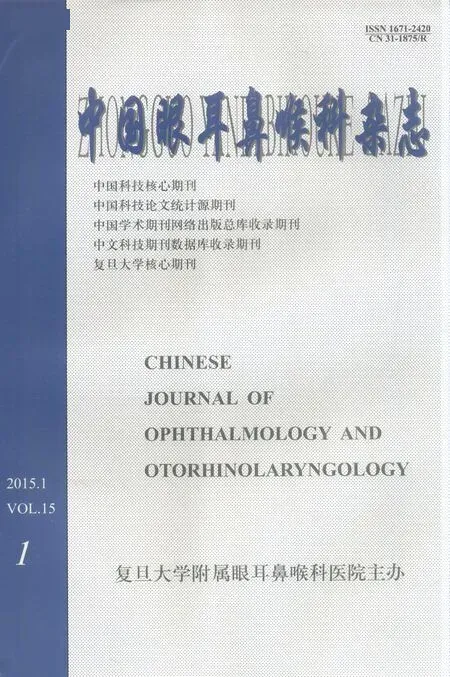内耳疾病诊治的不同认识
王正敏
·院士笔谈·
内耳疾病诊治的不同认识
王正敏
内耳深居颞骨岩部,未能被直接观察到,也甚难取得其病变组织作病理学检查,故内耳疾病至今仍是未被清楚查明的一类病变。虽然影像学、功能检测和生物化学检查所得的依据可用于诊断内耳畸形、遗传、药物中毒和外伤等病因可查得的内耳疾病,但发病率高的梅尼埃病和良性阵发性位置性眩晕在著名的《Schuknecht’s耳病理学》(Merchant SN, Nadol JB Jr, 2010,第3版)一书中仍被列在病因不明或多因性的一章中。其他如影像学明确可见的上半规管裂也被质疑是否负责同耳发生的症状。由于这类内耳疾病病因不明或可能是多因性的,因此目前对其的临床诊断和治疗仍多是推理和探索性的。
1 梅尼埃病
本病经典的病理依据是在尸解颞骨组织学表现的膜迷路积水。因其初始病因不知,诊断用名为“原发性内淋巴积水”。破密“原发性”是最终阐明梅尼埃病病因和机制的任务。单纯疱疹病毒1型(herpes simplex virus 1, HSV-1)常在感染者三叉神经节内终身潜伏,并随时可被激活而引起复发性唇疱疹,这一事实令人猜想HSV-1也可能潜伏感染前庭神经节和螺旋神经节,并被随时激活造成内耳损害,例如具有反复突发的梅尼埃病。国外多篇文献报告,梅尼埃病前庭神经超微结构显示神经变性,而神经变性有可能是炎症的结局。已有多篇国外专家报道梅尼埃病与HSV感染有关。如在梅尼埃病患者血清中检查到病毒特异性免疫球蛋白E(IgE);外淋巴中有高水平HSV抗体;在人颞骨尸检中虽可检测到HSV潜伏感染,但其中患有梅尼埃病的HSV感染率高于一般群体[1-9]。相关文献报告有:环氧合酶 2(cyclooxygenase 2, COX-2)可在炎性和变性脑病中生成,COX抑制药物可降低鼠眼HSV-1激活等。HSV-1能诱导体外培养的前庭神经元高表达COX-2,而COX抑制剂非甾体抗炎药能抑制前庭神经元培养体系中HSV-1的繁殖和再激活。此项实验为非甾体抗炎药临床治疗梅尼埃病的应用提供一定的依据[10-18]。
2 良性阵发性位置性眩晕
又名嵴帽沉石病和管沉石病。本病的主要临床表现是发作于头部位置改变时的眩晕,是由半规管壶腹嵴帽内有沉石在头位变化时诱发。文献报道在566例1 031只颞骨病理检验中,嵴帽内有嗜碱性沉积物的可达22%,可见于各半规管,沉积物大小也不等。对于沉积物是否含钙物,仍未有结论。至于嵴帽内的沉积物是来自椭圆囊斑或球囊斑的砂膜,还是嵴帽蛋白的变性(嵴帽是支持细胞产生的糖蛋白)还有待进一步判定。对头位施以加速度变动可消除症状的原理被认为是,贴附在嵴帽上从砂膜移位过来的“耳石”得到复位。另一种解释是,嵴帽内沉积物在加速度运动时,因其惯性而脱出嵴帽。其自然脱落可资解释本病为何可不治自愈。管沉石病的重要依据是有专家报告其在术中后半规管开放时发现白色离散颗粒,但尸检颞骨病理学研究从未有管内“结石”的报道。迄今为止,尚未在颞骨病理检查中发现有椭圆囊斑和球囊斑砂膜脱落的证明[19-25]。
3 上半规管裂
有文献报告596例1 000只颞骨组织学检查中有上半规管裂的发生率可达2%,并认为婴儿上半规管在弓状隆起处会相当薄,随着发育长大才渐变厚。成人上半规管变薄或成裂与其管壁发育受阻有关。上半规管在弓状隆起弓背处管壁厚度若<0.1 mm,在CT上就不易显示,可能被误诊为管壁全层缺失。上半规管骨壁完全缺失仍可有完整骨膜。骨膜及覆盖其上的硬膜和充满脑脊液的蛛网膜下隙可产生足够抗力防止骨膜破裂和骨迷路开放。抗力可减少或消除外淋巴液流侧向压力导致的顺应变动而保护膜迷路。有专家认为,上半规管裂成为产生临床症状和体征的“第三窗”,应有“第二事件”存在。第二事件可能是颅外伤或颅内压升高。所以,诊断上半规管裂综合征应该综合分析CT、诱发症状及体征的声强大小、耳内压变化和既往史等[26-31]。
内耳疾病的病因、发病机制和转归及诊治至今仍是富有挑战性和亟待揭秘。随着相关基础研究的不断发现和临诊科学技术水平的提高,内耳疾病的诊疗会踏上新的台阶。
[ 1 ] Gacek RR, Gacek MR. Ménière's disease as a manifestation of vestibular ganglionitis[J]. Am J Otolaryngol, 2001, 22(4):241-250.
[ 2 ] Gacek RR. Ménière's disease is a viral neuropathy[J]. ORL J Otorhino laryngol Relat Spec, 2009,71(2):78-86.
[ 3 ] Arbusow V, Schulz P, Strupp M, et al. Distribution of herpes simplex virus type 1 in human geniculate and vestibular ganglia: implications for vestibular neuritis[J]. Ann Neurol, 1999,46(3):416-419.
[ 4 ] Gacek RR. Evidence for a viral neuropathy in recurrent vertigo[J]. ORL J Otorhino laryngol Relat Spec, 2008,70(1):6-14.
[ 5 ] Adour KK, Byl FM, Hilsinger RL Jr, et al. Ménière's disease as a form of cranial polyganglionitis[J]. Laryngoscope, 1980, 90(3):392-398.
[ 6 ] Arnold W, Niedermeyer HP. Herpes simplex virus antibodies in the perilymph of patients with Ménière disease[J]. Arch Otolaryngol Head Neck Surg, 1997, 123(1):53-56.
[ 7 ] Bergström T, Edström S, Tjellström A, et al. Ménière′s disease and antibody reactivity to herpes simplex virus type I polypeptides[J]. Am J Otol, 1992, 13(5):295-300.
[ 8 ] Vrabec JT. Herpes simplex virus and Ménière′s disease[J]. Laryngoscope, 2003, 113(9):1431-1438.
[ 9 ] Shimeld C, Whiteland JL, Williams NA, et al. Cytokine production in the nervous system of mice during acute and latent infection with herpes simplex virus type 1[J]. J Gen Virol, 1997, 78 (12):3317-3325.
[10] Phillis JW, Horrocks LA, Farooqui AA. Cyclooxygenases, lipoxygenases, and epoxygenases in CNS: their role and involvement in neurological disorders[J]. Brain Res Rev, 2006, 52(2):201-243.
[11] Choi SH, Aid S, Bosetti F. The distinct roles of cyclooxygenase-1 and -2 in neuroinflammation: implications for translational research[J]. Trends Pharmacol Sci, 2009, 30(4):174-181.
[12] Minghetti L. Cyclooxygenase-2 (COX-2) in inflammatory and degenerative brain diseases[J]. J Neuropathol Exp Neurol, 2004, 63(9):901-910.
[13] Baker DA, Thomas J, Epstein J, et al. The effect of prostaglandins on the multiplication and cell-to-cell spread of herpes simplex virus type 2invitro[J]. Am J Obstet Gynecol, 1982, 144(3):346-349.
[14] Ray N, Bisher ME, Enquist LW. Cyclooxygenase-1 and -2 are required for production of infectious pseudorabies virus[J]. J Virol, 2004, 78(23):12964-12974.
[15] Shimomura Y, Higaki S, Watanabe K. Suppression of herpes simplex virus 1 reactivation in a mouse eye model by cyclooxygenase inhibitor, heat shock protein inhibitor, and adenosine monophosphate[J]. Jpn J Ophthalmol, 2010, 54(3):187-190.
[16] Higaki S, Watanabe K, Itahashi M, et al. Cyclooxygenase (COX)-inhibiting drug reduces HSV-1 reactivation in the mouse eye model[J]. Curr Eye Res, 2009, 34(3):171-176.
[17] Gebhardt BM, Varnell ED, Kaufman HE. Inhibition of cyclooxygenase 2 synthesis suppresses herpes simplex virus type 1 reactivation[J]. J Ocul Pharmacol Ther, 2005, 21(2):114-120.
[18] Liu Y, Li S, Wang Z. The role of cyclooxygenase in multiplication and reactivation of HSV-1 in vestibular ganglion neurons[J]. Scientific World J, 2014:912640.
[19] Schuknecht HF. Cupulolithiasis[J]. Arch Otolaryng,1969, 90(6):765-778.
[20] Lempert T, Tiel-Wilck K. A positional maneuver for treatment of horizontal-canal benign positional vertigo[J]. Laryngoscope, 1996, 106(4):476-478.
[21] Epley JM. Particle repositioning for benign paroxysmal positional vertigo[J]. Otolaryngol Clin North Am, 1996, 29(2):323-331.
[22] Parnes LS, McClure JA. Free-floating endolymph particles: a new operative finding during posterior semicircular canal occlusion[J]. Laryngoscope, 1992, 102(9):988-992.
[23] Buckingham RA. Anatomical and theoretical observations on otolith repositioning for benign paroxysmal positional vertigo[J]. Laryngoscope,1999, 109(5):717-22.
[24] Parnes LS, Agrawal AK. Benign paroxysmal positional vertigo[M]//Jackler RK, Brankmann DE. Neurotology. 2nd Edi. Mosby Inc, 2004:644-658.
[25] Moriarty B, Rutka J, Hawke M. The incidence and distribution of cupular deposits in the labyrinth[J]. Laryngoscope, 1992, 102(1):56-59.
[26] Carey JP, Minor LB, Nager GT. Dehiscence or thinning of bone overlying the superior semicircular canal in a temporal bone survey[J]. Arch Otolaryngol Head Neck Surg, 2000, 126(2):137-147.
[27] Mikulec AA, McKenna MJ, Ramsey MJ, et al. Superior semicircular canal dehiscence presenting as conductive hearing loss without vertigo[J]. Otol Neurotol, 2004, 25(2):121-129.
[28] Belden CJ, Weg N, Minor LB, et al. CT evaluation of bone dehiscence of the superior semicircular canal as a cause of sound- and/or pressure-induced vertigo[J]. Radiology, 2003, 226(2):337-343.
[29] Crane BT, Minor LB, Carey JP. Three-dimensional computed tomography of superior canal dehiscence syndrome[J]. Otol Neurotol, 2008, 29(5):699-705.
[30] Wilkinson EP, Liu GC, Friedman RA. Correction of progressive hearing loss in superior canal dehiscence syndrome[J]. Laryngoscope, 2008, 118(1):10-13.
[31] Carter MS, Lookabaugh S, Lee DJ. Endoscopic-assisted repair of superior canal dehiscence syndrome[J]. Laryngoscope, 2014,124(6):1464-1468.
(本文编辑 杨美琴)
复旦大学附属眼耳鼻喉科医院耳鼻喉科 卫生部听觉医学重点实验室 上海 200031
王正敏(Email:fjswzm2015@126.com)
10.14166/j.issn.1671-2420.2015.01.001
2014-12-22)

